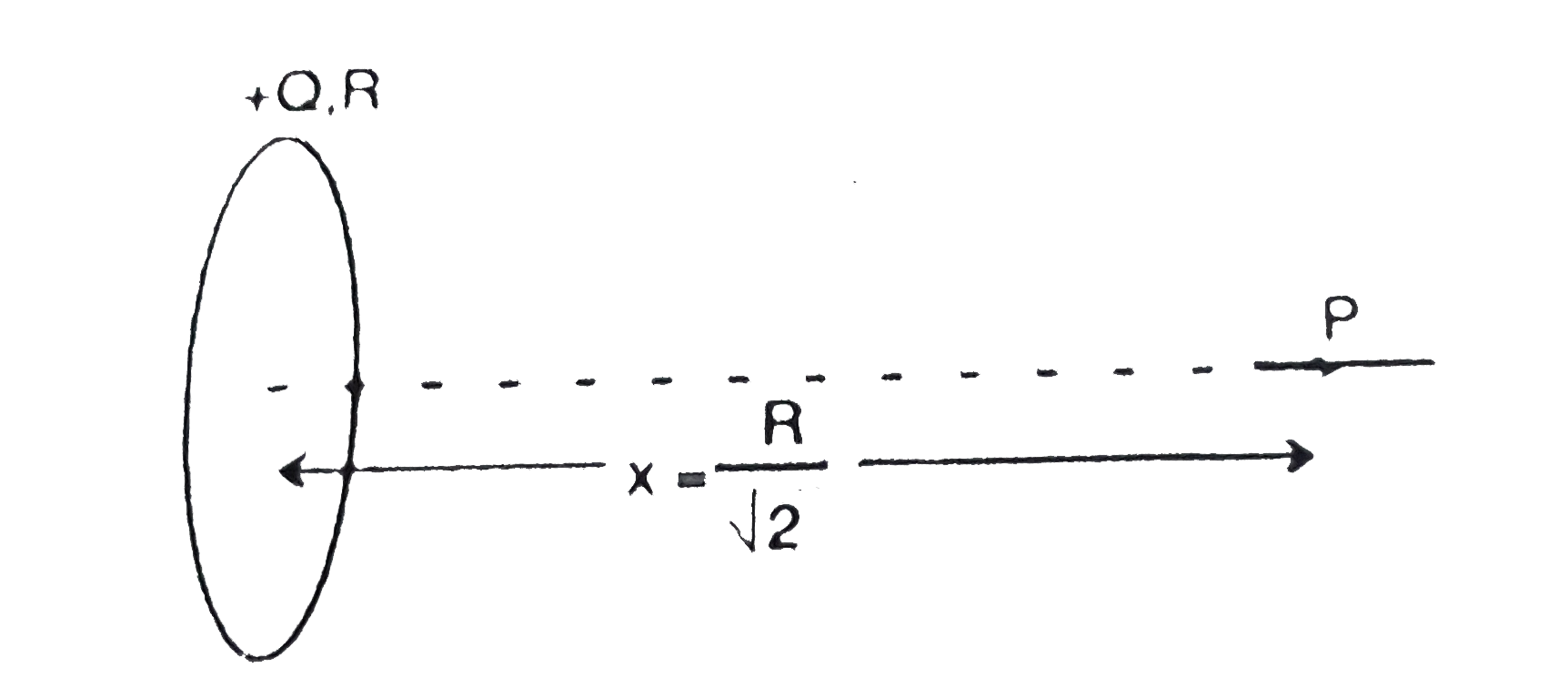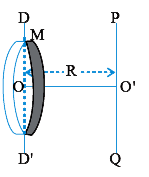A small electric dipole is kept on the axis of a uniformly charged ring at distance R/√2 from the centre of the ring. The direction of the dipole moment is along the axis. The dipole moment is P, charge of the ring is Q and radius of the ring is R. The force on the dipole is nearly _____
To solve the problem of finding the force on a small electric dipole placed on the axis of a uniformly charged ring, we can follow these steps:
1. Understanding the Setup:
- We have a uniformly charged ring with total charge Q and radius R.
- The dipole is placed at a distance x=R√2 from the center of the ring, along the axis of the ring.
2. Electric Field Due to the Ring:
- The electric field E at a distance x along the axis of a charged ring is given by the formula:
E=kQx(R2+x2)3/2
where k=14πϵ0.
3. Substituting the Distance:
- Substitute x=R√2 into the electric field equation:
E=kQ(R√2)(R2+(R√2)2)3/2
- Simplifying the denominator:
R2+(R√2)2=R2+R22=3R22
- Therefore, the electric field becomes:
E=kQ(R√2)(3R22)3/2=kQ(R√2)(3√3R34)=4kQR3√3√2R3
4. Finding the Force on the Dipole:
- The force F on the dipole in an electric field is given by:
F=PdEdx
where P is the dipole moment.
5. Calculating the Derivative of the Electric Field:
- To find dEdx, we need to differentiate the expression for E with respect to x. However, we can observe that at the position x=R√2, the symmetry of the electric field due to the ring leads to a situation where the electric field does not change with small displacements along the axis.
6. Conclusion:
- Since the derivative dEdx at this point is zero (due to symmetry), we find that:
F=P⋅0=0
- Therefore, the force on the dipole is nearly zero.
Final Answer:
The force on the dipole is nearly 0.
- We have a uniformly charged ring with total charge Q and radius R.
- The dipole is placed at a distance x=R√2 from the center of the ring, along the axis of the ring.
- The electric field E at a distance x along the axis of a charged ring is given by the formula:
E=kQx(R2+x2)3/2
where k=14πϵ0.
- Substitute x=R√2 into the electric field equation:
E=kQ(R√2)(R2+(R√2)2)3/2
- Simplifying the denominator:
R2+(R√2)2=R2+R22=3R22
- Therefore, the electric field becomes:
E=kQ(R√2)(3R22)3/2=kQ(R√2)(3√3R34)=4kQR3√3√2R3
- The force F on the dipole in an electric field is given by:
F=PdEdx
where P is the dipole moment.
- To find dEdx, we need to differentiate the expression for E with respect to x. However, we can observe that at the position x=R√2, the symmetry of the electric field due to the ring leads to a situation where the electric field does not change with small displacements along the axis.
- Since the derivative dEdx at this point is zero (due to symmetry), we find that:
F=P⋅0=0
- Therefore, the force on the dipole is nearly zero.
The force on the dipole is nearly 0.
Topper's Solved these Questions
- ELECTROSTATICSBook:AAKASH SERIESChapter:ELECTROSTATICSExercise:PRACTICE SHEET (EXERCISE - I COULOMB.S INVERSE SQUARE LAQW) (LEVEL -I (MAIN) STRAIGHT OBJECTIVE TYPE QUESTION
Explore 5 Videos
- ELECTROSTATICSBook:AAKASH SERIESChapter:ELECTROSTATICSExercise:PRACTICE SHEET (EXERCISE - I COULOMB.S INVERSE SQUARE LAQW) (LEVEL - II (ADVANCED) MORE THAN ONE CORRECT ANSWER TYPE QUESTION)
Explore 4 Videos
- ELECTROSTATICSBook:AAKASH SERIESChapter:ELECTROSTATICSExercise:LECTURE SHEET (EXERCISE - V) (LEVEL - II (ADVANCED) MATRIX MATCHING TYPE QUESTIONS)
Explore 1 Video
- ELECTROMAGNETICSBook:AAKASH SERIESChapter:ELECTROMAGNETICSExercise:ADDITIONAL EXERCISE
Explore 13 Videos
- ELEMENTS OF VECTORSBook:AAKASH SERIESChapter:ELEMENTS OF VECTORSExercise:QUESTIONS FOR DESCRIPTIVE ANSWERS
Explore 10 Videos
Similar Questions
An electric dipole is kept on the axis of a uniformly charged ring at distance from the centre of the ring. The direction of the dipole moment is along the axis. The dipole moment is p, charge of the ring is Q & radius of the ring is R. The force on the dipole is
View SolutionA short dipole is placed on the axis of a uniformly charged ring (total charge -Q, radius R) at a distance R√2 from centre of ring as shown in figure. Find the Force on the dipole due to that ring

View SolutionThe maximum electric field intensity on the axis of a uniformly charged ring of charge q and radius R will be
View SolutionThe electric field of an electric dipole at a point on its axis , at a distance d from the centre of the dipole, varies as
View SolutionA dipole of dipole moment →p=pˆi lies along the x -axis in a non-uniform electric field →E=cxˆi . The force acting on the dipole is
View SolutionA particle of mass m is kept on the axis of a fixed circular ring of mass M and radius R at a distance x from the centre of the ring. Find the maximum gravitational force between the ring and the particle.
View SolutionThe moment of inertia of a ring of mass M and radius R about PQ axis will be

View SolutionA dipole is kept near an infinite line of charge. If the net force on the dipole is zero, then its dipolse moment is
View SolutionCalculate potential on the axis of a ring due to charge Q uniformly distributed along the ring of radius R.
View SolutionAlong the axis of a dipole, direction of electric field is always in the direction of electric dipole moment p. Is this statement true of false?
View Solution